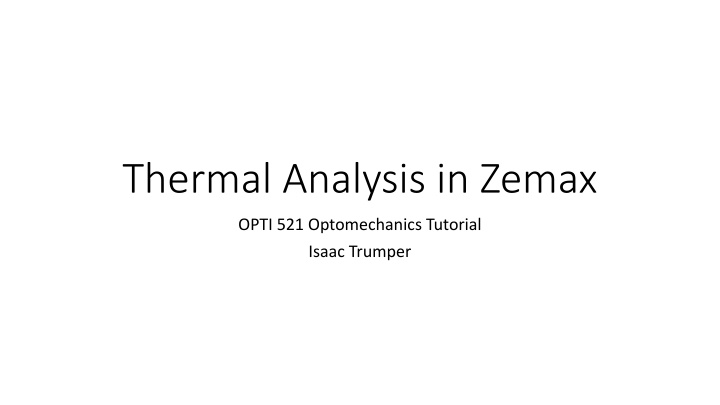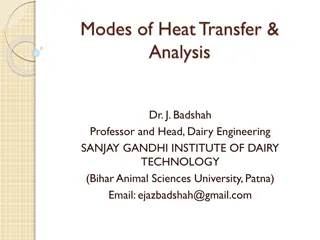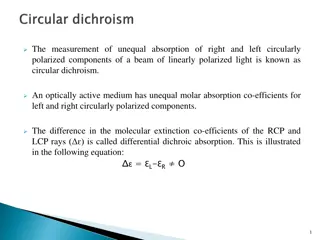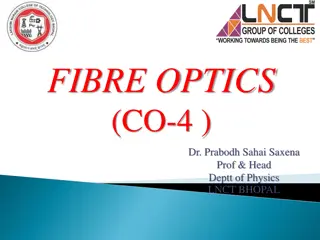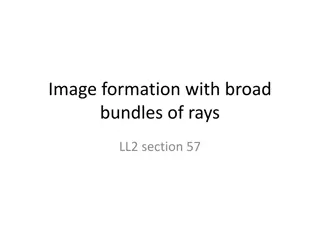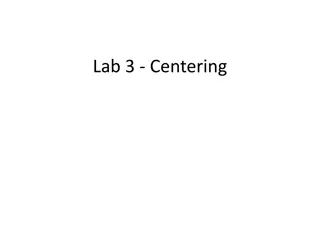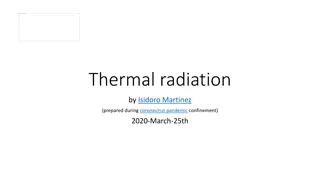Thermal Analysis in Optical Systems: Modeling Effects and Optimization
Thermal Analysis, Optical Systems, Zemax, Optomechanics, Modeling
Download Presentation

Please find below an Image/Link to download the presentation.
The content on the website is provided AS IS for your information and personal use only. It may not be sold, licensed, or shared on other websites without obtaining consent from the author.If you encounter any issues during the download, it is possible that the publisher has removed the file from their server.
You are allowed to download the files provided on this website for personal or commercial use, subject to the condition that they are used lawfully. All files are the property of their respective owners.
The content on the website is provided AS IS for your information and personal use only. It may not be sold, licensed, or shared on other websites without obtaining consent from the author.
E N D
Presentation Transcript
Thermal Analysis in Zemax OPTI 521 Optomechanics Tutorial Isaac Trumper
What is a thermal analysis? Optical systems are used in a variety of environments, so we model the effects due to the change in temperature, pressure, etc. Different applications will have different requirements for the range of parameters that the lens needs to operate over. Military applications typically require 50 C
As temperature changes Materials expand or contract as a function of temperature, which will change the nominal optical design. Most designs and materials are given at 1 Atm and 20 C or 25 C depending on the manufacturer. We assume this change in length is linear, so the new length is ? = ? 1 + ? ? where L is the nominal length, is the thermal coefficient of expansion, and ? is the change in temperature.
As temperature changes The material properties will also change. Specifically, the index of refraction of glasses varies as a function of temperature. BK7: ?? ??= 3.6 10 6/ This means that a lens will change its focal length given by ? ?? ?? ? ?? = ? 1 where f is the nominal focal length, n is the nominal index of refraction, and ? is the change in temperature.
Zemax modelling Fortunately for us, the optical design software will take all of these effects into account and allow us to optimize our design over a range of environments. Zemax models the change in radii of the lenses to determine the spacing between lenses, change in length of the material between lenses, and the change in power of the lens elements. With all this information, we can optimize the optical design to yield the best performance, usually by making the lenses as insensitive to environmental variations as possible.
Preparing an optical design First, we need to have a nominal design form. For this tutorial we will use a Zemax default lens:
Creating multiple environments The nominal design is specified at 20 C, but we would like to investigate its performance from 0 C - 30 C (-32 F 86 F).
Creating multiple environments Because Zemax uses a linear model for its temperature effects, choosing the min, max, and nominal temperatures is okay, but more is required for systems that use aspherics or complex surfaces. Note that the temperatures are specified in the system units
Review multi-configuration data Running the previous command automatically sets up a multi- configuration lens with the correct operands for environmental analysis But what is wrong?
Mechanical housing data In the nominal design, we have not defined a physical material that connects all the lenses, so this spacing will not change over temperature. We must model our mechanics to get correct results!
Updated thermal model Specifying the material between the first and second lens as aluminum results in variation of the thickness of surface 3
All aluminum housing Aluminum: ? = 23.6 10 6/ Zemax expects its thermal coefficient of expansion (TCE) data in units of 1E-06 per degree C, so we enter aluminum as TCE = 23.6. 0 C 30 C
Compare with Invar 36 Invar 36: ? = 1.3 10 6/ Almost zero variation across the full temperature range 0 C 30 C
Optimizing athermal lenses We can now optimize the optical design to work across the different temperatures. Define variables only in the nominal configuration found within the multi-configuration editor. Typical variables are thicknesses (THIC) and curvature/radii (CRVT). We can also optimize for the best housing material, or spacer material by setting the TCE data as variable. This is set back in the lens data editor. However, this may choose an unphysical material, so we need to take care.
Limitations of thermal analysis Tilted, decentered, or unconventional optical systems cause issues when Zemax computes edge thickness, which is how the thermal expansions are calculated. Material property information should be verified for accuracy, especially when operating in a range not specified by the manufacturer. Take care that the Zemax model accurately represents how the lenses will be mounted. Use dummy surfaces to achieve more complex mounting schemes.
